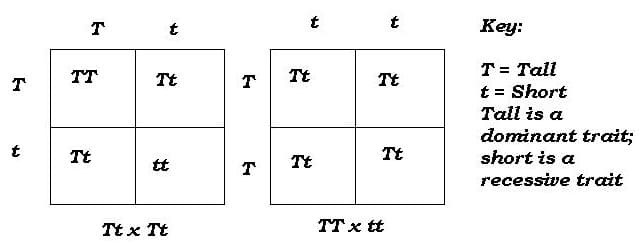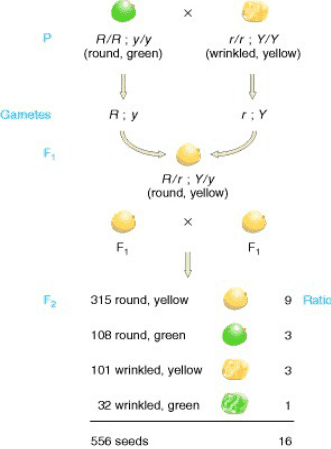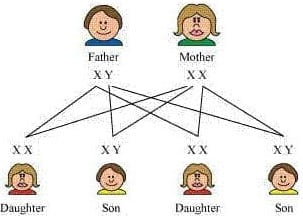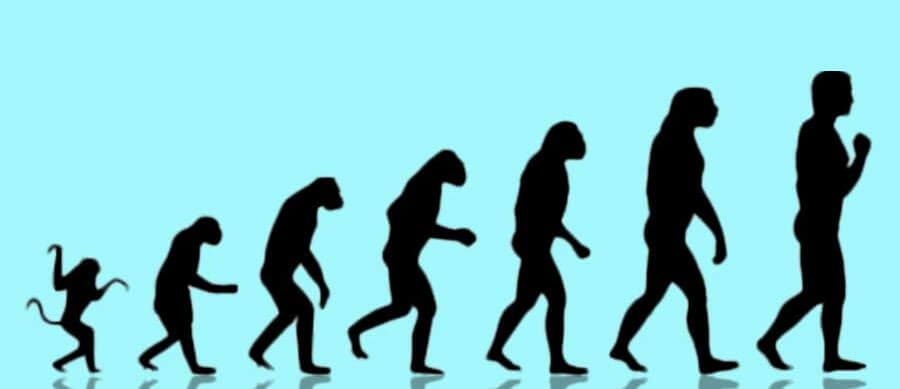In this article, we are going to cover a significant topic of biology and the class 10 syllabus that is heredity and evolution class 10 notes. This article is meant to help students grasp the concept of heredity and evolution easily and excel in their exams.
In this article, we have provided heredity and evolution class 10 notes for the students. They can refer to these notes where we have covered every topic of significance to make it easier for the students to understand the concept in a brief language. The heredity and class 10 notes will help them remember the key concepts and understand them better.
Heredity and evolution Class 10 notes
What is Genetics?
It is the branch of science concerned with the study of genes, heredity, and genetic variations.
What is Heredity?
The phenomenon of the transmission of characters or traits from parents to their offsprings is defined as heredity.
What are Variation and causes?
The difference between parents and their offsprings or the differences of the individuals belonging to one species are called variations. The various reasons that contribute to variation are crossing over, changes in the environment, mutation, and gene recombination.
There is an inbuilt tendency in every organism to carry variations by copying DNA during reproduction. They’re some variations acquired by an organism during its lifetime; they are called acquired variations.
Somatic variation:
The next generations do not inherit somatic cells, and the variations occurring in the somatic cells are called somatic variations.
Gametic variation:
These variations are inherited in the next generation, so these are called inherited traits. The variations which occur in the germ cells are called Gametic variations.
Importance of variations:
Variations are the basis for heredity and evolution. Because of variations, the chances of survival of an organism according to the changes in the environment increase.
Genotypes:
Completes a set of genes in the genome of an organism
Phenotypes:
These are observable characters, and many of them cannot be inherited.
Clones:
Organisms that are an exact copy of each other.
Diploid:
Complete set of paired chromosomes, one inherited from each parent.
Haploid:
Single chromosome or unpaired set of chromosomes.
DNA, RNA is the genetic material present in an organism
Gregor Mendel conducted the first study on inheritance through his experiments on the garden pea plants.
Work on inheritance by Gregor Mendel:
Gregor Mendel, the Austrian Monk, started his experiments in 1882 and 1884 and coined the laws of inheritance. His work earned him the name “father of genetics” through his experiments; he observed the inheritance in the pea plants (Pisum Sativum). His experiments were conducted in the garden behind his monastery. His experiments became the foundation of modern genetics.
The law of inheritance is based on the concept that both parents, mother, and father, contributes equally to the genetics of the offspring.
The law of inheritance was classified into three basic laws: the law of dominance, segregation, and the law of independent assortment.
Important terms:
Chromosomes: Present in the nucleus of a cell, have long tread like structure, they carry hereditary information of a cell in the form of genes.
Genes: A gene is a part of a chromosome; genes control specific biological functions.
DNA: DNA is a chemical present in a chromosome that has characteristics or traits coded in it.
Contrasting characters: these are the characters that are visible such as long-short, tall-dwarf, white -red, round-wrinkled.
Recessive: A character that is present in a generation but isn’t expressed is recessive. E.g. Dwarfness
Dominant: A character that is expressed in a generation is dominant. E.g., tallness homozygous: When both the genes present are of the same type, they are called homozygous.eg tallness-TT.
Heterozygous: When both the genes present are of different types, they are called heterozygous. Tt for tallness. Where T is for tallness and T is for a dwarf.
Homologous: When both genes present are for the same character, and in the same position, while the mother contributes one and the father contributes another in a pair of characters, they are called homologous.
Mendel’s Experiments:
Medel chose a set of contrasting characters for his pea plants such as wrinkled seeds/round seeds, tall/short, white flowers/violet flowers.
Monohybrid cross:
Monohybrid cross is the type of cross where only one pair of contrasting characters was considered while crossing two pea plants. He conducted a cross between short (t) and a tall (T) pea plant for a monohybrid cross.
When tall (T) plants were crossed with short (t) plants, only tall plants were obtained. These plants are called the F1 generation (first filial generation) (Tt in the above example).

In the cross between F1 generation(Tt) plants were self-pollinated to get the F2 generation. Here, not all plants were tall.there were 75% of tall plants, and the remaining 25% were dwarf or shorts, making the phenotype 3:1. This shows that they inherited both tallness and shortness in the F1 generation, but they expressed only tallness. Thus tallness is the dominant character and shortness recessive.
The f2 generation had a genotype of 1:2:1 representing TT: Tt: tt.
From the above observations, Mendell coined the law of segregation:
There is a pair of alleles for every character passed by every individual.
A gamete receives only one trait from the alleles during the form, the action of gamete, and a particular character can be recessive or dominant in a generation.
Law of dominance: only one character is expressed in offspring when parents with pure contrasting characters are crossed. The character which is expressed is the dominant character and which is not expressed is the recessive character.
Dihybrid cross: Dihybrid cross is the type of cross in which two pairs of contrasting characters were considered while crossing two plants.
Mendel conducted a dihybrid cross to observe the inheritance in the plants with two pairs of contrasting characters. In this experiment, the two plants with the contrasting character he chose were plants with green round seeds and wrinkled yellow seeds. In the f1 generation, only plants with yellow round seeds were obtained, concluding that yellow and round were a dominant character, and green and wrinkled were the recessive characters. He then self-pollinated the plants obtained in the f1 generation to obtain f2 generation plants.

In the f2 generation, he obtained plants with yellow round, green round, yellow wrinkled, and green wrinkled traits. And the ratio was 9:3:3:1 which represented yellow round: green round: yellow wrinkled: green wrinkled.
Thus Mendel coined the third law of inheritance, the law of independent assortment: The law of segregation stated that during the formation of the gametes, the alleles of distinct characters get separated independently without mixing. In this example, the alleles of the seed texture and those of seed colour were separated from each other independently.
Sex determination:
How is sex determined in different organisms?
The temperature at which the fertilized egg is kept decides the sex of the offspring in some animals—E.g. turtles.
In some cases, sex isn’t genetically determined. Animals like snails can change sex.
Whereas in human beings, the determination of the sex of the offspring is based on genetics. Genes that the offspring inherits from the parents determine the sex.
Sex determination in human beings:
In the case of human beings, there are a total of 23 pairs of chromosomes present. Out of these 23, not all are paired chromosomes. 22 chromosomes are paired and are called autosomes, the last pair of chromosomes is called as sex chromosome for it determines the sex of an individual.

Human females have a perfect pair of these sex chromosomes represented by XX while in males, the sex chromosome is odd and not having a perfect pair. In human males, there is a normal X chromosome and a short Y chromosome making it a pair represented by XY. The homogenetic female produces all the same gametes, i.e. they have X chromosomes, whereas the heterogenetic male produces two types of sperms, i.e. one X chromosome and one Y chromosome.
In humans, the presence of two X chromosomes in the genetic factor leads to a female child, whereas the presence of the XY chromosome leads to the birth of a male child. As the only male can pass on the Y chromosome, the sex of the baby in humans depends on the male parent and which chromosome has been fertilized.
There are different types of sex determinations for example in humans- (XX-XY), in chickens (ZW-ZZ), in insects (XX-XO), in case of moths and butterflies it is (ZO-ZZ).
Key terms to remember:
Sex chromosomes: chromosomes that determine the sex of the offspring are sex chromosomes.
If x chromosome present in the sperm fertilizes the ovum, which is having an X chromosome, the offspring would be female with XX sex chromosome.
If the Y chromosome present in the male sperm fertilizes the x chromosome of the ovum, then the offspring would be male with XY chromosomes.
The above chart shows that half offsprings would be
male and half would be female. Every child will receive or inherit an X chromosome from the mother, both boys, and girls. Thus, a child can Inherit a y chromosome only from the father. Thus the sex is determined by what an offspring inherits from the father.
Genetic variations:
The diverse gene pool occurring due to the difference in the DNA sequence of every organism is called genetic variations, which lead to differences in the biochemical or physical characters.
Also, read Difference between Economic Growth and Economic Development
Natural selection:
The phenomenon by which favourable characteristics or
traits of organisms belonging to a species are selected. The changing conditions of nature put pressure on every species to adapt to the conditions for their survival. Natural selection defines that in the species those who adapt to their changed conditions are selected by nature, survive and reproduce. The organisms those who fail to adapt to the conditions they are exposed to are rejected by nature and perish.
Speciation: New species develop from the pre-existing species by the process of speciation. Speciation occurs due to evolutionary forces such as isolation, genetic drift, natural selection.
Genetic drift: the change in the frequency of an allele that happens randomly in a population over generations is called genetic drift. Due o genetic drift, the variation in the g
genetic composition of a population increases.
Gene flow: The interbreeding between the individuals of the same population or population of the same species lead to the exchange of the genetic material this is called gene flow.
Population: a group of plants, animals or any other living organisms that can reproduce and have fertile, viable offspring makes a population or community.
Charles Darwin:
Charles Darwin was an English biologist and a naturalist. He is known as the father of evolution. He introduced a theory called the “theory of natural selection”. His five years expedition in a ship helped him write his theory. He published his book, theory of evolution in 1859. Darwin put his theory in detail in the book.
Evolution and fossils:
Evolution:
Every organism has an inbuilt tendency to carry variations and characteristics to the next-generation due to the copying of DNA. Genetic variations lead to evolution. Genetic variations occur due to sexual reproduction. Evolution happens from the gradual changes which are passed on to a population over several years. These changes make the species better adapted to their environment and also sometimes give rise to the new species.
Origin of species:
Charles Darwin wrote the book “Origin of Species” which mostly described the details of his theory of natural selection.
Origin of life- Haldane’s theory:
According to the theory of British scientist JBS Haldane, the origin of life occurred from lifeless and organic matter. This theory was later proved to be true Urey, and Miller’s experiment called the theory of abiogenesis.
Evolutionary evidence-fossils:
Among so many pieces of evidence that support the theory of evolution, fossils are the biggest proof. Fossils are preserved dead remains of the ancient animals and plants that died and remained buried under the earth over millions of years.
With the help of fossils, we can understand the anatomy and physiology of these organisms. Through this study, we can understand how evolution took place over the million years and gave rise to the formation of the species that we see around us today.
Formation of fossils: Fossils make important pieces of evidence for evolution.
Upon dying, the organisms remain buried under the earth. Wit
h time, the soft tissues decompose and leave the bones and shells behind with time sediments build over the bones and upon hardening turn into rock. Later, the process of petrification happens in which the minerals replace the cells as the bone begins to decay. Ones the bones have completely decayed the cast of the animal is left. Which makes a fossil.
Palaeontology is the study of fossils.
Also, read Aristotle: The Father of Biology.
Evolutionary relationships:
Studying the analogous and homologous organs will help us understand the evolutionary relationships of animals.
Homologous organs: Organs that have a similar structure but different functions are called homologous organs.
Example 1: Limbs of birds and forelimbs in mammals have similar structures and different functions. They are modified to perform different functions.
Example 2: Brains of all mammals, fishes vertebrates have the same pattern.
Example 3: Barberry plant spine and tendril in pea plant both perform different functions and are leaves with modifications.
Analogous organs: organs that have similar functions but different structures and evolutionary origins too are called analogous organs.
Wings in bats, birds, and insects: They are different in structure but have the same functions.
Leaves in Opuntia and leaves in Peepal: Peepal leaves are normal leaves, and opuntia leaves are modified into stems. They both perform photosynthesis.
Vestigial organs: vestigial organs are the organs that were once functional in our ancestors, but through evolution have lost their function, they are rudimentary.
Embryology: Embryology studies how embryo in different organisms develops. It has revealed that organisms belonging to different species have common ancestors.
Evolution by stage: The process of gradual evolution is called evolution by stage; it is a slow process and caused by the changes to the DNA during the reproduction. The
evolution of almost every organism has several stages, there isn’t sudden evolution in the complex organs, it happens slowly, and with limited usage at certain stages. The feathers of a bird evolved because of the survival advantage of intermediate stages.
Artificial selection: Special phenotypic characters are selected by artificial selection for the production of the organisms that have enhanced traits. Through artificial selection, a single species can evolve into many species.
Also, read How to Make Money Online in India for Students: Top 15
Molecular phylogeny:
Molecular phylogeny is an evolutionary relationship between different biological species which gives rise to the tree of evolution. According to this, during reproduction, changes in DNA are the basic events of evolution. There will be greater differences in the DNA of the organisms that are distantly similar to each other.
Human Evolution:
the study of human evolution happens through excavation, fossils, determination of DNA sequences, and time dating. This study proves that all humans belong to a species called Homo Sapiens, which came from Africa and spread around the world over the years. Humans are single-species even in the presence of great diversity among them around the world.

